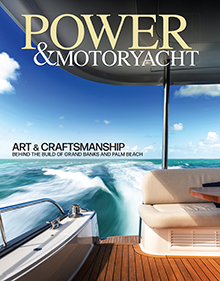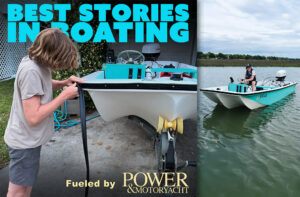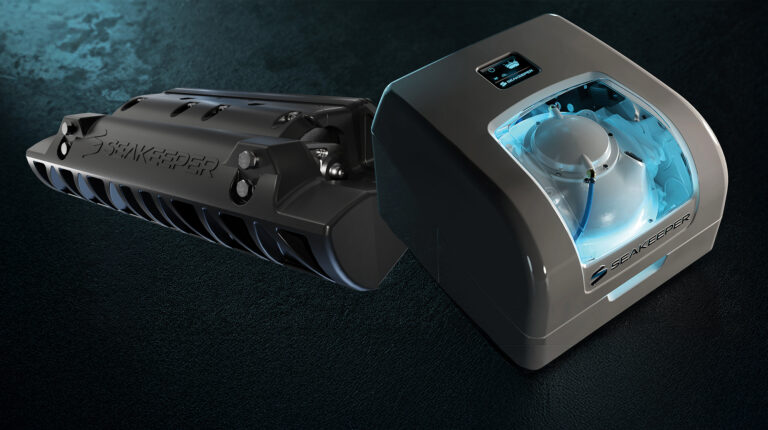
Backed by its previous experiences with electric marine propulsion, Vetus introduces two new, innovative “e-mobility” products.
Back in the ‘80s, shortly after I’d started working for Power & Motoryacht, I was dispatched to a marina in Connecticut to check out a device that was entirely new to recreational boating, but altogether old hat on commercial vessels: a bow thruster. At the time, Vetus Den Ouden (a Dutch company known around the world today as Vetus) was touting what it then called a “bow prop,” cleverly installed in a fiberglass tunnel that ran transversely through a 40-some-foot cruiser, a couple of feet abaft her stem and well below her waterline. The thing sported a small electric motor, a modest battery bank, and an even more modest 3-kW or 4-hp rating. Despite its novelty, faint-heartedness and rather adumbrated run time, the little gizmo soon gained traction with the boating public and went on to establish a genuine foothold within the recreational boating realm.
A couple decades later, Vetus took another step into the future of e-mobility with a fully electric, 24-volt, inboard-type propulsion package, the EP2200. To create it, the company more or less reoriented a bow thruster, directing it astern instead of transversely. But the 2200 never achieved mainstream popularity. Not only did it require large traction or semi-traction batteries for power and an ample auxiliary cooling circuit to control running temperatures, but horsepower equivalency was low, 24-volt battery chargers (rare at the time) were necessary for system compatibility and charge times were reported in the dreary 14-hour range.
The Dutch are an inventive, resolute lot, though, and apparently somewhat electrically motivated. Just a few months ago, Vetus brought yet another set of marine e-mobility products to market, one descriptively called the “E-Pod” and the other called, just as descriptively, the “E-Line.” Although presently targeted for sailing vessels and small European canal boats, the technology the two products represent is likely to synergize with higher-horsepower e-mobility solutions in the future, not just from Yanmar (Vetus’ forward-leaning parent company) but from the recreational marine industry at large.

The E-Pod is indeed pod-like. Within a boat’s hull, it combines motor, suspension, cooling, gearbox, clutch and prop shaft into one complete, easily installed component. Under the hull, it mounts a rim-drive, aft-facing, electrically powered propeller in a nozzle-like composite shroud secured just ahead of the boat’s rudder. Although the shroud is fixed and therefore incapable of directing thrust, Vetus is investigating the possibility of adding directionality, according to Chris DeBoy, president of Vetus America. “We’re looking into it for sure,” he says, “and we may very well have something next year.”
The E-Line is somewhat more conventional. It’s a straight-shot inboard package with a propeller and shaft on one end and an electric motor on the other. Vetus says the E-Line will produce 22 hp of internal combustion equivalent thrust at full speed. Maximum equivalent thrust for the E-Pod is 20 hp. According to DeBoy, Vetus will maintain a 40- or 45-hp cutoff on its e-mobility offerings, while parent company Yanmar will deal with more powerful developments.
But regardless of which company logo appears, there’s an aspect to the new Vetus technology that will likely be represented in some shape or form—a patented “Motor Controller” that governs the operation of both the E-Pod and the E-Line in a very sophisticated way. The controller uses very complex, highly innovative circuitry to replicate a three-stage battery charger while, at the same time, both converting and boosting direct-current input from a common 24-volt battery bank to run a not-so-common (but way more efficient and powerful) 48-volt, brushless, alternating-current electric motor while simultaneously energizing the battery bank that goes with it.
“We’re actually the first company to do this sort of thing,” explains DeBoy. Additional features of the new controller include a relay function that ensures the amount of charge in a source battery bank never falls below a level that maintains good battery health, and a monitoring function that makes virtually all system parameters (extent of charge, voltage level, amperage draw, etc.) constantly available to an operator.
“E-mobility on the water continues to evolve,” Deboy concludes. “Right now, I don’t think I can go out there and buy an electrical solution that will allow me to use my 20-foot center console the way I’m used to using it. But the technology is coming.”










